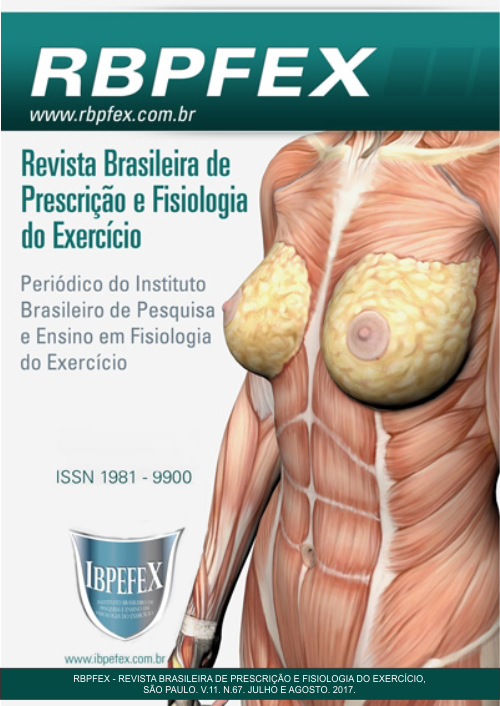Acute effect of the agonist / antagonist method on the number of repetitions in the movement of flexion of the knee with charge of 10 RMs
Abstract
The aim of the study was to investigate the acute effect of the agonist / antagonist method (AA) on the number of repetitions of knee flexion with load of 10 RMs. They volunteered for the study 10 males (26.7 ± 6.7 years, 177 ± 8 cm, 95.3 ± 9.8 kg and BMI of 30.21 ± 3.2) with experience in strength training for at least six months. Data collection was performed in three non-consecutive days. On the first day of tests were conducted anthropometric measurements and 10 maximum repetitions test (10 RMs) for knee extension (extensor chair), after two days for knee flexion (leg curl). On the third day was performed with a series of 10 load knee extension of MRs and then was performed a knee flexion series with the loads 10 to MRs concentric failure. To measure the load one MRI before and after testing, a one RM prediction equation was used. The comparison was performed using a Wilcoxon test for nonparametric data. With the load of 10 RMs came to the number of 13 ± 1.4 repetitions, making a significant difference between the predicted load of 10 RMs and performance in agonist-antagonist system. The results suggested that the agonist-antagonist method improves the performance and strength in bending motion of the knee under the conditions suggested in the study.
References
-Achour Júnior, A. Bases para o exercício de alongamento relacionado com a saúde e no desempenho atlético. Midiograf. 1996.
-Batista, J. S.; Martins, A. D.; Wibelinger, L. M. Avaliação da força muscular (torque muscular) de flexores e extensores de joelho de indivíduos jovens. Lecturas: Educación Física y Deportes. Buenos Aires. Maio 2012.
-Baechle, T.R.; Earle, R.W.; Wathen, D. Resistance training. In Essentials of strength training and conditioning, Eds. T.R. Baechle; R.W. Earle. Champaign, IL: Human Kinetcs. 2000.
-Baechle, T. R.; Groves, B. R. Treino de força: Passos para o sucesso. 2ª edição. Artmed. 2000.
-Bean, A. O guia completo de treinamento de força. Manole. 1999. p. 53.
-Brooks, D. S. O livro completo para o treinamento personalizado. Phorte. 2008. p. 463.
-Carregaro,R. L.; Cunha, R. C.; Cardoso, J. R.; Pinto, R. S.; Bottaro, M. Efeitos da ordem de pré-ativação dos músculos antagonistas nas respostas neuromusculares dos extensores do joelho. Revista Brasileira de Fisioterapia. Vol. 15. Núm. 6. p. 452-459. 2011.
-Carvalhais, V. O. C.; Santos, T. R. T.; Araújo, V. L.; Leite, D. X.; Dias, J. M. D.; Fonseca, S. T. Força muscular e índice de fadiga dos extensores e flexores do joelho de jogadores profissionais de futebol de acordo com o posicionamento em campo. Revista Brasileira de Medicina do Esporte. Vol. 19. Núm. 6. p. 452-456. 2013.
-Delgado, C.; Fernandes Filho, J.; Barbosa, F. P.; Oliveira, H. B.; Utilização do esfigmomanômetro na avaliação da força dos músculos extensores e flexores da articulação do joelho em militares. Revista Brasileira de Medicina do Esporte. Vol. 10. Núm. 5. 2004.
-Fleck, S. J.; Kraemer, W. J. Fundamentos do treinamento de força muscular. 3ª edição. Porto Alegre. Artmed. 2006. p. 204.
-Lacio, M. L.; Damasceno, V. O.; Vianna, J. M.; Lima, J. R. P.; Reis, V. M.; Brito, J. P.; Fernandes Filho, J. Precisão das equações preditivas de 1 RM em praticantes não competitivos de treino de força. Motricidade. Vol. 6. Núm. 3. p. 31-37. 2010.
-Maynard, J.; Ebben, W. P. The effects of antagonist prefatigue on agonist torque and electromyography. Journal of Strength and Conditioning Research. Vol. 17. Núm. 3. p. 469-474. 2003.
-Nobre, M.; Figueiredo, T.; Simão, R. Influência do método Agonista-Antagonista no desempenho do treinamento de força para membros inferiores. Revista Brasileira de Prescrição e Fisiologia do Exercício. Vol. 4. Núm. 22. p. 397-401. 2010. Disponível em: <http://www.rbpfex.com.br/index.php/rbpfex/article/view/264/266>
-Paz, G. A.; Maia, M. F.; Lima, V. P.; Miranda, H. Efeito do método Agonista-Antagonista comparado ao tradicional no volume e ativação muscular. Revista Brasileira de Atividade Física & Saúde. Vol. 19. Núm. 1. p. 54-63. 2014.
-Paz, G. A.; Maia, M. F.; Santiago, F. L. S.; Santos, P. S.; Lima, V. P. Efeitos imediatos da pré-atividade máxima dos antagonistas sobre a tensão isométrica máxima e sinal eletromiográfico. Revista Brasileira de Prescrição e Fisiologia do Exercício. Vol. 6. Núm. 32. p.149-156.2012. Disponível em: <http://www.rbpfex.com.br/index.php/rbpfex/article/view/381/389>
-Pereira, M. I. R.; Gomes, P. S. C. Testes de força e resistência muscular: Confiabilidade e predição de uma repetição máxima –Revisão e novas evidências. Revista Brasileira de Medicina do Esporte. Vol. 9. Núm. 5. p. 325-335. 2003.
-Solomonow, M.; Baratta, R.; Zhou, B. H.; Shoji, H.; Bose, W.; Beck, C.; D’ambrosia,R. The synergistic action of the anterior cruciate ligament and thigh muscles in maintaining joint stability. The American Journal of Sports Medicine. Vol. 15. Núm. 3. p. 207-213. 1987.
-Wibelinger, L. M.; Schneider, R. H.; Tonial, A. M.; Oliveira, G. M.; Klein, B. M.; Capitânio, D. Avaliação da força muscular de flexores e extensores de joelho em indivíduos idosos socialmente ativos. Revista Brasileira de Ciências do Envelhecimento Humano. Vol. 6. Núm. 2. 2009.
Authors who publish in this journal agree to the following terms:
- Authors retain the copyright and grant the journal the right of first publication, with work simultaneously licensed under the Creative Commons Attribution License BY-NC which allows the sharing of the work with acknowledgment of the authorship of the work and initial publication in this journal.
- Authors are authorized to enter into additional contracts separately for non-exclusive distribution of the version of the work published in this journal (eg, publishing in institutional repository or book chapter), with acknowledgment of authorship and initial publication in this journal.
- Authors are allowed and encouraged to post and distribute their work online (eg, in institutional repositories or on their personal page) at any point before or during the editorial process, as this can bring about productive change as well as increase impact and impact. citation of published work (See The Effect of Free Access).






